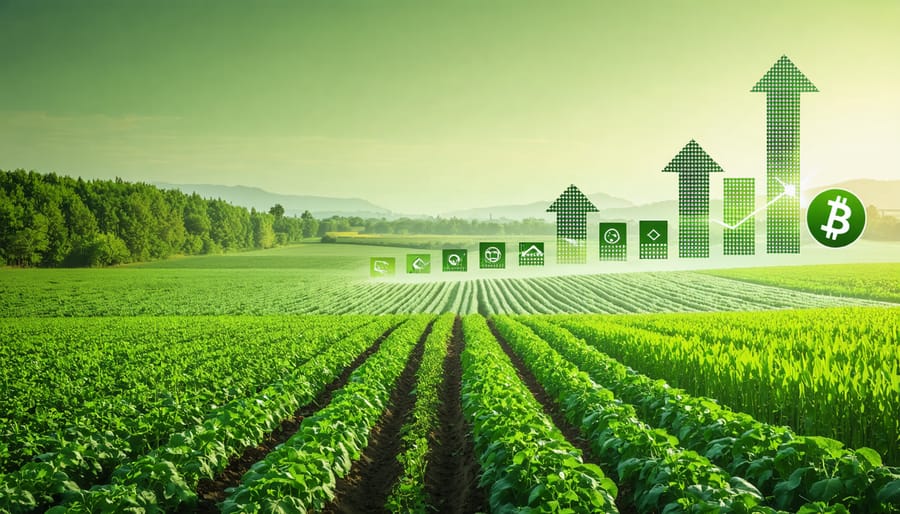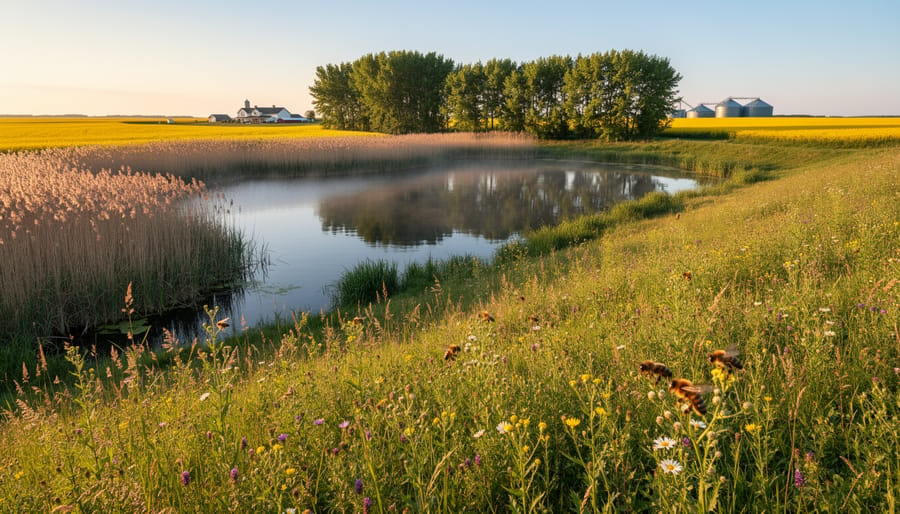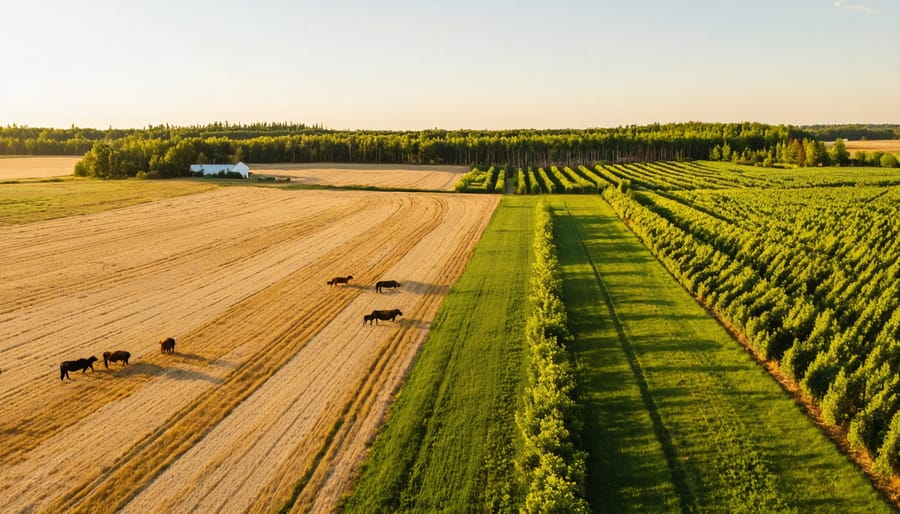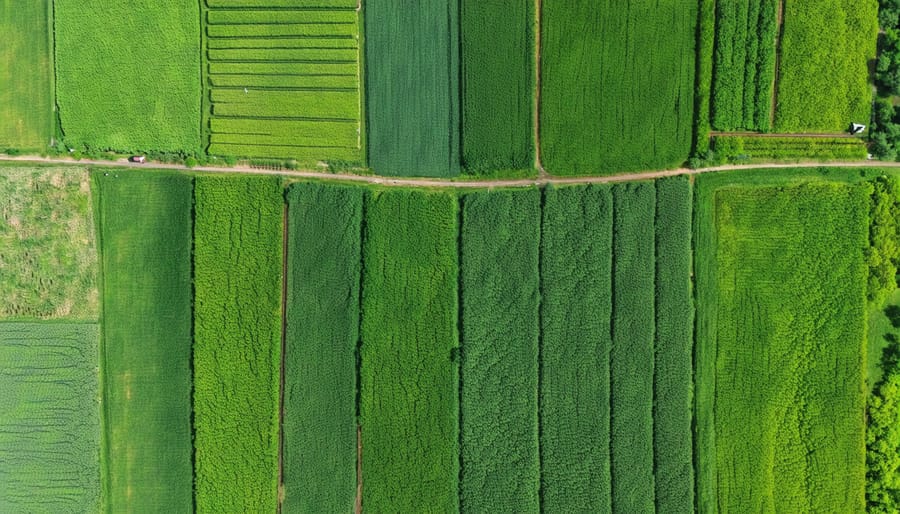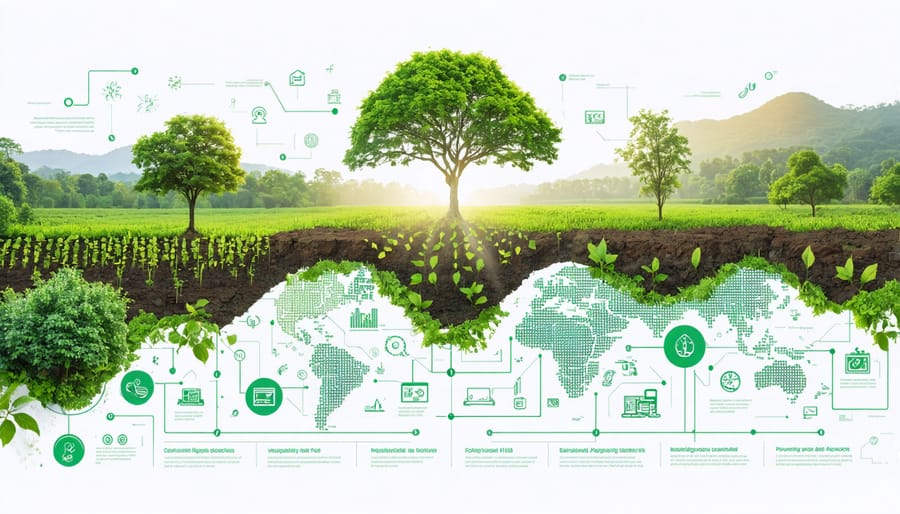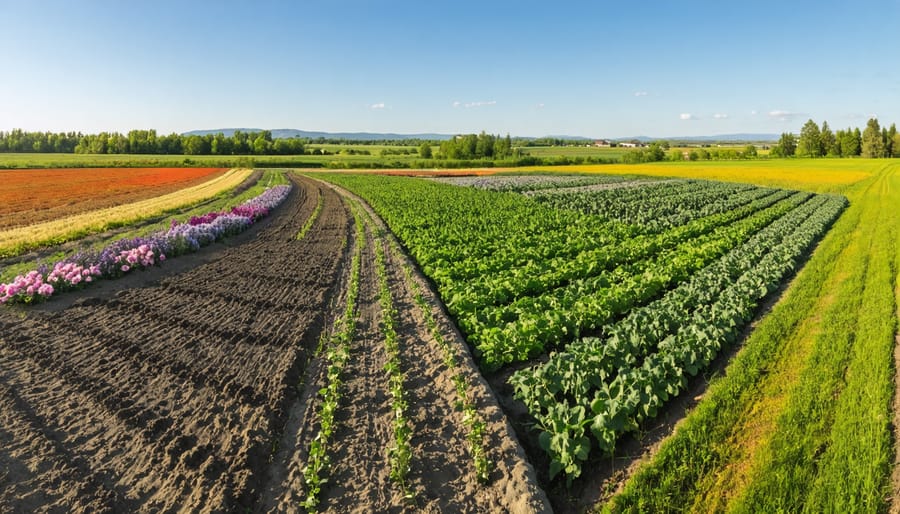Transform your farmland into a powerful carbon sink while generating additional revenue through carbon credit programs. Alberta farmers are now earning an average of $30-45 per acre annually by implementing regenerative farming practices that sequester atmospheric carbon. These market-based incentives, combined with improved soil health and increased crop yields, create a compelling business case for agricultural carbon management.
Modern carbon farming integrates seamlessly with existing operations, requiring minimal equipment changes while delivering multiple revenue streams. By adopting practices like reduced tillage, cover cropping, and strategic crop rotation, farmers across Alberta have already banked over 15 million tonnes of carbon credits since 2007. The province’s established carbon market, robust verification systems, and growing demand from industrial buyers make this an opportune moment for agricultural producers to capitalize on carbon sequestration.
This practical guide explores how your farm can participate in carbon credit programs, from initial soil testing to credit verification and sale, with real examples from successful Alberta operations.
Carbon Credits: Your Farm’s New Cash Crop
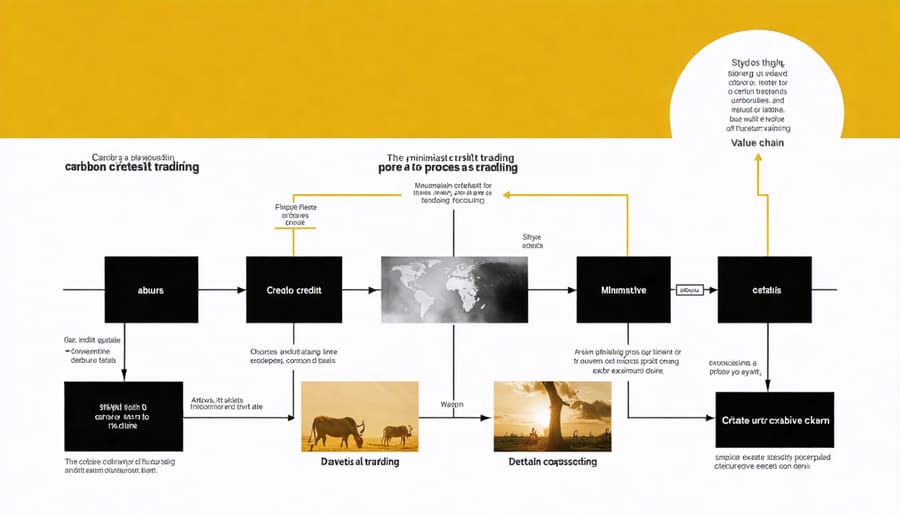
Understanding Agricultural Carbon Credits
Agricultural carbon credits represent a financial reward for farming practices that reduce greenhouse gas emissions or sequester carbon in the soil. When you implement practices like no-till farming, cover cropping, or precision nutrient management, you’re effectively storing carbon that would otherwise be released into the atmosphere.
Think of carbon credits as a receipt for your environmental stewardship. For every tonne of carbon dioxide equivalent (CO2e) that your farm captures or prevents from being released, you earn one carbon credit. These credits can then be sold to organizations looking to offset their emissions.
In Alberta’s agricultural context, carbon credits are verified through approved protocols that measure and document your carbon-reducing activities. Common practices that qualify include reducing fertilizer use through precision agriculture, implementing rotational grazing systems, and maintaining permanent cover crops.
What makes agricultural carbon credits unique is their dual benefit: they not only generate additional income but also often lead to improved soil health, better water retention, and increased crop resilience. For many Alberta farmers, this creates a win-win situation where sustainable practices align with economic opportunities.
Current Market Values in Alberta
As of 2024, Alberta’s carbon credit market continues to show strong potential for farmers. Current prices range from $50 to $65 per tonne of carbon sequestered, with the provincial average hovering around $58. These values represent a 15% increase from the previous year, reflecting growing demand from industrial buyers.
Local aggregators are offering competitive rates, with some farmers reporting earnings of $25-30 per hectare annually through sustainable practices like no-till farming and cover cropping. The market has shown particular strength in credits generated through soil carbon sequestration and methane reduction projects.
Many Alberta farmers are finding success by bundling their credits through cooperative agreements, which typically yield 10-15% higher returns compared to individual sales. The forecast for 2024-2025 suggests continued growth, with analysts predicting prices could reach $70-75 per tonne as Canada moves toward its emissions reduction targets.
For perspective, a 400-hectare farm implementing approved carbon sequestration practices could potentially generate $10,000-12,000 in additional annual revenue through carbon credits, making it an increasingly attractive option for diversifying farm income.
Proven Carbon Farming Practices That Work in Alberta
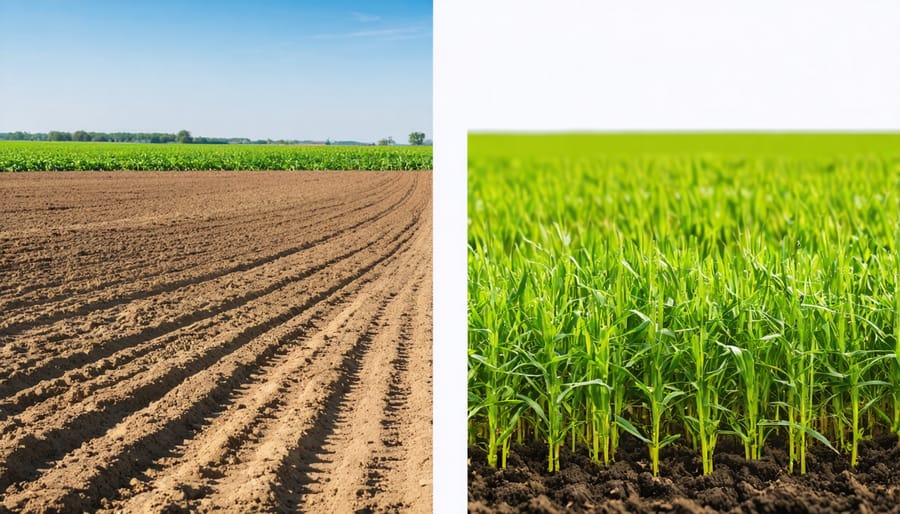
No-Till Farming Success Stories
The Brown family farm in Lethbridge has become a regional success story since implementing no-till practices five years ago. Sarah Brown reports that their soil organic carbon levels have increased by 15% while reducing fuel costs by nearly $40,000 annually. “We were skeptical at first,” Sarah admits, “but the combination of carbon credits and operational savings has made this transition incredibly worthwhile.”
In Red Deer, Mark Peterson’s 2,000-hectare operation demonstrates how soil health improvement techniques can transform productivity. After three years of no-till farming, Peterson documented a 20% increase in water retention and earned $15,000 in carbon credits through the Alberta Carbon Credit Program.
The Matthews’ family farm near Medicine Hat presents another compelling case. Their transition to no-till practices in 2019 initially faced challenges with residue management, but they persevered. “We adapted our seeding equipment and timing,” explains Tom Matthews. “Now we’re seeing better yields, especially during dry seasons, and we’ve qualified for carbon credits two years running.”
These success stories highlight a common thread: while the transition requires careful planning and some initial investment, the combination of improved soil health, reduced operational costs, and carbon credit revenue creates a sustainable model for long-term profitability.
Cover Crop Strategies
In Alberta’s climate, selecting the right cover crops plays a crucial role in developing sustainable agricultural systems while maximizing carbon credit potential. Winter-hardy options like fall rye and winter triticale excel in our prairie conditions, providing excellent soil protection during harsh winters and early spring growth.
Legumes such as field peas and red clover are particularly valuable, offering dual benefits of nitrogen fixation and carbon sequestration. These crops can add up to 70 kg of nitrogen per hectare while building soil organic matter. Brassicas like forage radish and turnips work well as late-summer plantings, with their deep root systems helping break up compacted soil layers and capture nutrients that might otherwise be lost.
For shorter growing windows, consider fast-establishing species like oats or barley, which can provide significant biomass in just 60 days. These crops are especially useful following early-harvested crops like peas or cereals. Multi-species mixes, combining cereals, legumes, and brassicas, often yield the best results for carbon sequestration and soil health improvement.
When selecting cover crops, consider your rotation, soil type, and moisture conditions. Many Alberta farmers find success with drought-tolerant species like Persian clover or hairy vetch, which establish well even in drier conditions while contributing to soil carbon levels.
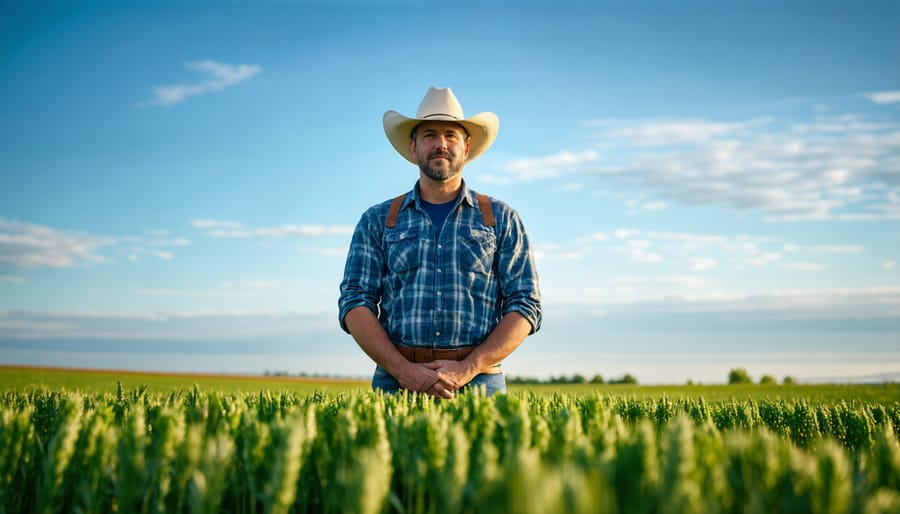
Rotational Grazing Benefits
Rotational grazing stands out as one of the most effective ways livestock producers can contribute to carbon sequestration while earning carbon credits. By strategically moving cattle between pastures, farmers allow grass to recover fully between grazing periods, leading to deeper root systems that store more carbon underground.
In Alberta, successful rotational grazing systems typically divide pastures into smaller paddocks, with cattle moved every 3-7 days depending on grass growth and seasonal conditions. This practice not only improves soil health but can sequester up to 2 tonnes of carbon per hectare annually, according to research from the University of Alberta.
Local rancher Sarah Thompson from Red Deer County shares, “Since implementing rotational grazing five years ago, we’ve noticed improved grass recovery, better drought resistance, and increased organic matter in our soil. The carbon credits are an added bonus to the overall benefits we’re seeing.”
Key benefits include:
– Enhanced soil organic matter and water retention
– Improved pasture productivity and carrying capacity
– Reduced feed costs through better forage utilization
– Additional income through carbon credit programs
– Greater resilience to climate variations
To qualify for carbon credits, farmers must document their grazing management practices and demonstrate improved carbon sequestration over time. Working with local agricultural extension services can help establish baseline measurements and develop an effective rotational grazing plan.
Getting Started with Carbon Credit Programs
Certification Requirements
To participate in carbon credit farming programs, farmers must meet specific certification requirements and maintain detailed documentation throughout the process. The foundation starts with establishing a baseline of current farming practices and carbon levels in your soil through professional testing and assessment.
Key documentation requirements include detailed field records, input logs, and management practice documentation spanning at least three years. These records should outline your circular farming approaches and carbon sequestration activities, such as cover cropping, reduced tillage, or precision agriculture implementation.
Verification involves regular third-party audits conducted by approved verification bodies. In Alberta, these auditors must be accredited through the Alberta Carbon Registries. They’ll review your documentation, conduct site visits, and verify that your practices align with approved protocols.
Essential requirements include:
– Detailed maps of field boundaries and management zones
– Soil testing results from accredited laboratories
– Equipment calibration records
– Photographic evidence of implemented practices
– Input purchase receipts and application records
– Crop rotation and yield data
– GPS data for precision agriculture activities
Most programs require annual reporting and verification, with documentation maintained for a minimum of seven years. Working with a qualified carbon program advisor can help ensure your documentation meets all requirements and streamline the certification process. Many agricultural extension offices offer support services to help farmers navigate these requirements effectively.
Available Support Programs
Several support programs are available to help Alberta farmers navigate the carbon credit market and maximize their potential earnings. The Alberta Carbon Offset System offers comprehensive guidance and resources for agricultural producers looking to participate in carbon credit programs.
The Canadian Agricultural Partnership (CAP) provides funding opportunities for farmers implementing sustainable practices that generate carbon credits. Through CAP, producers can access grants covering up to 50% of eligible costs for soil health improvements, precision agriculture technology, and emissions reduction equipment.
Local agricultural societies and producer groups across Alberta offer workshops and training sessions on carbon credit program participation. The Alberta Conservation Association provides one-on-one consultations to help farmers identify suitable carbon credit opportunities and develop implementation strategies.
The Environmental Farm Plan (EFP) program assists farmers in assessing their operations’ environmental impact and identifying areas for improvement. Completing an EFP can help farmers prepare for carbon credit program participation and may qualify them for additional funding support.
Technical assistance is available through Alberta Agriculture and Forestry’s network of extension specialists. These experts provide guidance on practice implementation, documentation requirements, and verification processes. Many agricultural service boards also offer soil testing services and equipment rentals to support carbon credit-generating activities.
For indigenous farmers, the First Nations Carbon Credit Program offers specialized support and resources tailored to their unique needs and circumstances. Additionally, several private aggregators operating in Alberta provide project development assistance and handle the administrative aspects of carbon credit generation and sales.
Remember to contact your local agricultural fieldman or extension office to learn more about specific programs available in your area.
Real Results: Alberta Success Stories
Meet Tom Anderson, a third-generation farmer from Lacombe County, who transformed his 2,000-hectare grain operation into a carbon credit success story. “I was skeptical at first,” Tom admits, “but after implementing no-till practices and cover cropping, we’ve generated nearly $15,000 in carbon credits annually while improving our soil health.”
In Strathmore, Sarah Martinez runs a mixed farming operation where she’s combined traditional cattle grazing with innovative carbon sequestration techniques. “We introduced rotational grazing patterns and planted shelter belts three years ago,” she explains. “Not only have we earned carbon credits, but we’ve also seen a 20% increase in soil organic matter.”
The Wilson family farm near Red Deer showcases how precision agriculture can boost carbon credit earnings. “Using GPS-guided equipment and variable-rate technology, we’ve reduced our fertilizer use by 30%,” says Mark Wilson. “Last year, we earned carbon credits worth $12 per tonne while cutting our input costs.”
Perhaps one of the most inspiring stories comes from the Calgary area, where the Cooper family collective transformed 5,000 hectares into a carbon-farming powerhouse. “We started small with just 500 hectares under carbon management,” explains Lisa Cooper. “Now, our entire operation participates in the program, earning credits while building resilient soils for the next generation.”
These success stories share common elements: careful planning, consistent documentation, and patience. Each farmer emphasized the importance of working with qualified aggregators and maintaining detailed records. While initial investments in new practices or equipment were sometimes necessary, all reported positive returns within two to three years.
The key takeaway from these Alberta pioneers? Start small, learn from others, and focus on practices that make sense for your specific operation. As Tom Anderson puts it, “Carbon credits aren’t just about the extra income – they’re about building a sustainable future for Alberta agriculture.”
Carbon credit farming presents a valuable opportunity for Canadian farmers to contribute to climate solutions while developing additional revenue streams. By implementing sustainable practices like reduced tillage, cover cropping, and precision agriculture, farmers can generate verifiable carbon credits while improving soil health and farm resilience. Success in this emerging market requires careful planning, thorough documentation, and partnership with reputable carbon credit programs.
For farmers interested in getting started, the key steps include assessing current practices, selecting appropriate protocols, and connecting with local agricultural extension services for guidance. The Alberta carbon market offers established frameworks and support systems to help farmers navigate this process. While there may be initial challenges in adapting farm operations, the long-term benefits – both environmental and financial – make carbon credit farming a worthwhile consideration for forward-thinking agricultural operations.
Remember that you’re not alone in this journey. Connect with other farmers who have experience with carbon credits, and leverage available resources through provincial agricultural programs to build your carbon farming strategy.

